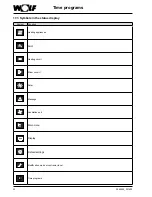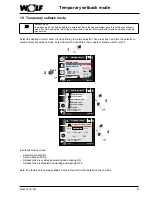
40
3064202_201602
Glossary
23 Glossary
Cascade
A cascade is a parallel connection of several heating appliances in order to
achieve a higher total output.
Contractor level
The setting options in the contractor level are reserved for the heating
contractor. This facility ensures your safety, since incorrect entries can cause
injury, or damage to the heating system.
Cylinder charging
Cylinder charging refers to the heating of a DHW cylinder that has an
internal indirect coil. To do this, a cylinder charging pump transports the
boiler water and therefore the heating energy to the heat exchanger of the
DHW cylinder.
DHW heating
The term DHW heating refers to the heating up of domestic hot water in a
DHW cylinder. This could be an instantaneous water heater, a DHW cylinder,
a DHW cylinder with internal indirect coil or a similar appliance.
eBUS
eBUS is a protocol for the networking of components in a heating system
with the aim of facilitating central control of the entire system.
ECO ABS
The ECO ABS (eco setback) function causes the heating system to switch
on/off automatically during setback mode if the average outside temperature
exceeds or falls below a specified value, for example if there are high
outside temperatures during the night.
Economy temperature
The economy temperature is the value that the set room temperature is
reduced to during periods of low usage.
Emissions test mode
Emissions test mode is only necessary for the flue gas test. The heating
appliance provides maximum heating output in emissions test mode (full
load operation). Emissions test mode terminates automatically either after
15 minutes or if the maximum flow temperature has been exceeded.
Flow temperature
Flow temperature refers to the temperature of the heating water flowing
to the radiator. It lies between 35 °C and 70 °C (depending on the outside
temperature) in heating control units which are regulated by the outside
temperature. In heating systems with pure surface heating, 25 °C to 40 °C is
adequate. In heating systems with no mixer circuit, the flow temperature is
the same as the temperature of the boiler water.
Frost protection
The contractor sets a temperature value on the BM-2 programming unit,
below which the heating appliance goes into the frost protection function.
The boiler circuit pump will start to operate continuously if the outside
temperature falls below the selected value. If the boiler water temperature
falls below 5 °C, the burner starts and heats the boiler up to the minimum
boiler water temperature.



































